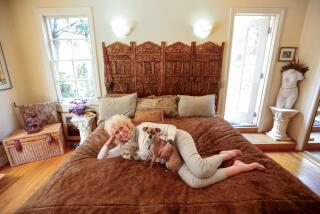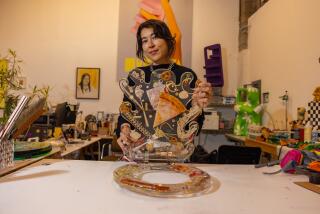The age of ease
- Share via
LAS VEGAS — A grab bar for the bathroom shower that makes you think “pretty” before “old.” A kitchen drawer for trash that makes you think “wow” before “useful.” A kitchen faucet with temperature presets that says “looks elegant” before “avoids burns.”
And then there were the toilets. Technology -- certainly for fun and in some cases to impress -- was everywhere at the Kitchen & Bath Industry Show at the convention center here last week. But often behind the LED-lighted musical commodes and cool automatic faucets was an effort to make the activities of daily life easier for all ages and abilities without sacrificing aesthetics.
There’s been a “night and day difference” in the last five years in what’s being offered to enable people to “age in place” without feeling that their home has been turned into a hospital, said Mary Jo Peterson, whose Connecticut-based interiors firm specializes in accessible design.
“Manufacturers are waking up and saying, ‘I need to do something’” to be part of the market for universal design, a concept that refers to designing for people of every age and ability, said Peterson, who spoke at a seminar at the show.
Salice was among several companies that displayed automated cupboard doors that require no handles. Europeans have been using them for years, but only recently have they become popular in this country, said Dennis Bean, a Salice sales official.
Just changing the color inside a drawer makes its contents easier to see. Lighted floor tiles, induction stoves and oversize shower stalls also were shown.
Installing LED strips around medicine cabinets or in drawers and cabinets, a trend at the show, also can help people see what’s inside more easily. LEDs don’t get hot, and they’re discreet and efficient, said Daryl Nauman, regional account manager for Hafele, a high-end kitchen hardware company.
Hafele’s booth held a number of clever solutions, including a step stool (list price $180) that can be installed under a cabinet; with a light kick, it slides out for use.
Drawer Box Specialties, a company in Orange, Calif., introduced its Helping Hands trash drawer (sold to cabinet makers for $525) that opens by touch and closes automatically.
“I’m getting older, and I don’t have the strength I had. And it’s not going to get better,” said Chief Executive Glen Blankenship, who is 70 and created it in part with himself in mind.
Kohler showed its Elevance Rising Wall Bath. One side of the tub can be raised and lowered, with minimum pressure. Another tub had a protruding seat that someone could use to transfer himself from a wheelchair, ideally without help. Or a parent could sit there to wash children.
Delta introduced a battery-operated faucet that senses the body’s electric current and turns on if a human is within four inches. It turns off immediately with a touch or in a minute if you walk away -- good for young and old alike, spokeswoman Mary McCullough said.
Boomer-inspired
There’s no question that the aging of the baby boom generation has fueled many such design innovations. People who no longer can get at pots and pans easily or set out a spread for a party might feel less confident and less inclined to entertain. That starts to isolate them.
Not so long ago, Peterson said, colleagues would react to her commitment to universal design by saying, “That’s nice, honey. You take care of those people and we’ll design for everyone.”
That doesn’t happen anymore, she said.
That’s in part because more homes are multigenerational. Four million U.S. households have three generations in them, Peterson said, citing U.S. Census data. And every day, as many as 10,000 baby boomers are turning 65. Remodeling can make economic sense when compared with the cost of in-home care, assisted living or nursing homes.
Not only are baby boomers entering retirement, but the economic downturn has affected who might be doing renovations.
“Slowly but surely, the U.S. home improvement industry is emerging from its worst downturn since the government began tracking spending in the early 1960s,” the Joint Center for Housing Studies at Harvard University said in a January report.
The report found that older people are among the industry’s strongest segments.
“The reason for that has to do with the unique characteristics of this downturn. The folks who really got hurt the worst would have been younger households,” Kermit Baker, director of the Remodeling Futures program at the center, said Tuesday by phone. People who have owned their homes for 20 years are “still sitting on equity” and, therefore, better able to spend money on their homes.
To some extent, universal design is a matter of perspective. Many people have for years refused to wear hearing aids that can be seen, but along comes Bluetooth and it’s suddenly “cool” to have some contraption sticking out of your ear, Peterson said.
Older yet stylish
That cool factor was key for the Naples, Fla., company Great Grabz.
Designer Abbie Sladick was inspired by a client who told her she would rather fall than have her friends know she had a grab bar in her bathroom. So Sladick started designing them, and the company showed colorful, fun designs in acrylic and metal at the Las Vegas show.
Officials at Blum, which makes kitchen cabinet hardware, realized that it’s not easy to understand people’s differing needs. So it uses an Age Explorer suit developed by a German firm that studies aging. With the suit and its accessories -- weights, earphones, glasses, gloves, bandages -- a person can feel what it’s like to be about 70, said Debbie Cannon, marketing services manager at Blum. The suit restricts the wearer’s range of motion, joint function, hear- ing, finger sensitivity and peripheral vision. It makes it difficult to pick up small items from the coun- ter, reach high into cupboards, distinguish among items of similar color and bend down.
Roberta Kravette, a New York designer who wore the suit for a demonstration, found she couldn’t open a plastic box and found it difficult to get a toaster from a low shelf. She hit her head when she tried to take a pile of plates from a cupboard. Overall, she said, she felt dizzy and uncertain.
Such research has led to Blum’s drawer, which holds stacks of plates and makes them easier to lift out than plates in a cabinet above shoulder height, Cannon said. Her company also showed a cupboard whose door swings upward and then closes by pushing an easy-to-reach button, as well as drawers that open all the way, so every bit of space can be used.
Blum and several other companies showed cupboards that open with a touch of the knee -- useful not only for people with limited dexterity, strength or balance, but also for anyone with hands full of food scraps to toss in the hidden trash bin. In fact, many of these ideas would be welcome by pregnant women or someone with a broken arm, Cannon noted.
The universal design products were among thousands for kitchens and baths that emphasized function in an uncertain economy. But times are rarely tough for everyone, and the booths showing off an assortment of high-end toilets that certainly could fit under the universal design umbrella attracted plenty of attention for many reasons.
A line formed all three days of the show to take a look at the Numi toilet from Kohler, a $6,390 toilet launched last week with LED night light, seat warmer, MP3 player docking station, motion sensor lid for automatic opening and closing, a gadget to warm the tile under your feet -- seemingly every bell and whistle except a bell and a whistle.
When the lid is opened, it slides back and up “so you’re always looking at the best surface of the product,” said Michael Marbach, product manager for toilets and bidets at Kohler.
“The Numi toilet is all about controlling your environment,” he said.
Toto, Inax and others offered twists on this once-mundane essential: minimalist designs in wood or bowls redesigned to clean better with a flush. Inax introduced its matte black Regio, which comes loaded with high-tech features and a list price of $7,350.
Company representatives noted that many of the toilets were low-flow and dual flush. Sit on the Numi for 60 seconds or fewer, and it figures the flush needs to be only 0.6 gallons. Sit longer, and the auto flush will use 1.28 gallons. Smart as it is, it won’t do the laundry or pay your bills.
For people who don’t already feel overwhelmed by the number of devices in their homes, several of these toilets operate by remote control that can be installed on the wall or -- for those who might not be able to reach it there -- on a stand or on the edge of the toilet seat.
“Believe it or not, there are many toilets that have a remote control,” Marbach said.
There’s another thing many luxury toilets have these days: bidets, or as Toto calls them, washlets.
It’s a product Americans are “very, very slowly” adjusting to, Peterson said.
But there will be a tipping point, because washlets address concerns about hygiene and are environmentally friendly, since users can reduce toilet paper consumption, said Lenora Campos, a spokeswoman for Toto U.S.A. A bidet also can give increased independence to a person who otherwise would need help using the bathroom.
But at least one company got the idea that bidets often are for pampering. Blooming Bidets’ slogan: “Love yourself with better hygiene.”
--



